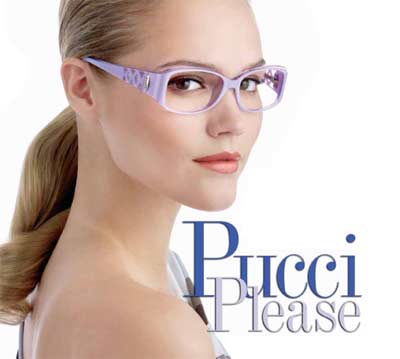
DISCOVERING THE ESSENCE AND EVOLUTION OF AN ICONIC BRAND SET TO DEBUT ITS NEW SUNWEAR AND EYEWEAR COLLECTIONS, EDITOR-IN-CHIEF JAMES J. SPINA EXPERIENCES AN EYEWEAR RENAISSANCE.
Pucci. I always thought it sounded like a kiss—a quick peck on the cheek, waking you up with a flash of color, a definite splash of distinctly Italian romance and a lingering image of body-hugging movement.
Where was I? You tell me. Oh… now I remember.
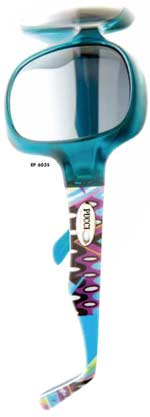
I’m in Florence for a precious glimpse into the past, present and future fashion whirl of Pucci, one of my favorite women’s designer brands, now set to debut new sunwear and eyewear collections from Marchon Eyewear. And quite frankly (and thankfully), there is no way to sidestep the aura of Florentine tradition, history and heritage pushing me toward delicious Italian overload.
No, it’s not jetlag. Florence is unique in its spiritual role as the junction of medieval pageantry and the rejuvenating, creative forces of the Renaissance. It might be the only place on earth where both those historical plateaus synthesized that which is ancient and that which is modern. And Emilio Pucci grasped that dichotomy throughout his whole life as an aristocrat, a fashion designer, an artist and an ambassador of freedom. His persona still kisses the narrow streets and the Ponte Vecchio of Florence. Pucci. And that kiss is heading for a tremendous bunch of beautiful faces (my grandmother always said “faccia bellas”) as Pucci eyewear renews its love affair with the eyes of the world.
The phrasing “quick stroll” could easily have been crafted to describe any destination walk you take in Florence. I’m quick strolling from my hotel overlooking the Arno River to the Pucci Palazzo and although the folks at Pucci have provided me with an elaborate street map, I never look at it. The famous fashion photos of Emilio Pucci priming his models on the tiled roof of the Pucci Palazzo invariably show the Duomo of Santa Maria del Flore as the background. And as if that sacred landmark isn’t enough, the palazzo is located on… via di’ Pucci.
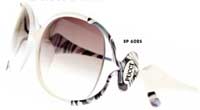 The man who signed
his work simply “Emilio”
delivered the signature of
his precious (Florence) and
grand (the whole earth)
heritage well. Readers
can trace some of
those personal and
brand highlights in
the timeline sidebar
but here and now on THIS
stroll we are passing languid
street banners and a
tiny, Florentine paper shop.
Every detail—every swirl of
color and quite nearly every
speck of sky, river and cobblestone—
is about to be reflected
and venerated in the new Pucci
frames. I’m escorted through a
gated courtyard and enter a room
of grand ball proportions.
The man who signed
his work simply “Emilio”
delivered the signature of
his precious (Florence) and
grand (the whole earth)
heritage well. Readers
can trace some of
those personal and
brand highlights in
the timeline sidebar
but here and now on THIS
stroll we are passing languid
street banners and a
tiny, Florentine paper shop.
Every detail—every swirl of
color and quite nearly every
speck of sky, river and cobblestone—
is about to be reflected
and venerated in the new Pucci
frames. I’m escorted through a
gated courtyard and enter a room
of grand ball proportions.
Paintings of Renaissance masters are hanging on the walls and dozens of eyeglasses and sunglasses are perched on small dining tables. Sorry if this sounds bated and breathless. For anyone who really cares about the state and status of eyewear the moment IS bated and breathless… and… well worth the greatest of expectations.
Initially eager to snoop around on a touch-and-feel sightseeking tour of all the new Pucci styles, I’m pleasantly startled when the spex-pedition is enhanced with narration by Giancarlo Agnoli, Marchon Italia’s managing director.
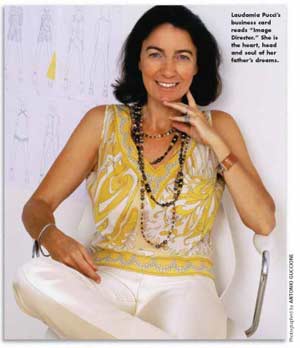
“The challenge for the whole team with Pucci was actually a positive reversal from the usual hunt for inspiration,” notes Agnoli. “Look around you. Look at this Palazzo. Look out that window at the city. Wait until you see the Pucci archives. Have them show you the room where Matthew [Williamson, Pucci’s Creative Director] color strategizes with authentic Pucci color swatches outnumbering the colors in a giant Pantone book. Even the shapes on the scarves and the fabric as it fits a body played right into our eyewear design work.” For Agnoli, “the inspiration was all ready with a blend of extravagance and sophistication that looked and fit like a most-modern-yetso- Pucci pair of glasses.”
The eyewear echoes that. Pick a frame… any frame. Sun style EP 601S swirls a dark to light blue zyl pattern that apes the Mediterranean Sea surrounding Capri—a ripple effect constantly varied in artistic waves in countless classic Pucci scarf designs. And yet in orange the same frame plays the design like the saturated sunnyside hills of Tuscany.
Or pick the inner temple coloration on style EP 606S where the power of Pucci to implode contrasts of yellow, brown, white and black remains unrivalled in clothing, accessories and now eyewear. The oval ripple effect in brushed silver and gold on frames in both the Rx and the sun collection harkens back to Italian Renaissance Guild flags and banners of Siena horse races and forward to silk jersey Pucci dresses of the ’50s, the ’80s and right now in a rainbow of new accessories. And never forget the Pucci signature Vivara—a print particular to the brand with a blue-that-hints-aqua and a pink-that-says-purple.
 “We once did runway sunglasses
that actually encased real fabric in
the plastic of the frame.” With that
low-key interjection and a solid,
swift handshake, Pucci’s daughter,
Laudomia, suddenly enters the
room. The title on her business card
reads “Image Director,” but she quite
literally has earned her fashion-
famous birthright name.
At ease and with a familiarity
that at once relaxes and
relates, Laudomia sets an
immediate tone of sincerity.
“We once did runway sunglasses
that actually encased real fabric in
the plastic of the frame.” With that
low-key interjection and a solid,
swift handshake, Pucci’s daughter,
Laudomia, suddenly enters the
room. The title on her business card
reads “Image Director,” but she quite
literally has earned her fashion-
famous birthright name.
At ease and with a familiarity
that at once relaxes and
relates, Laudomia sets an
immediate tone of sincerity.
“So can you see the quality as a prime consideration and expectation? We’ve dabbled with sunglasses for many years as a perfect Pucci accessory, but this time the details are perfect.” She relates, “It took teamwork, research and a tremendous dose of freedom, but we got there relatively easily because very early in the process Al [Berg] and the Marchon talent understood that it wasn’t just about our archives and our Italian heritage. My father was a man who always looked to the future for his direction and to the world for his influence.”
Laudomia attests Emilio’s love of America (he studied animal husbandry in Georgia and had a ski scholarship to Reed College in Portland, Ore.) and his devotion to an athlete’s freedom of movement as key elements to his design vocation. “My father had a complex life. He loved sports, especially skiing. He was a war hero, a great pilot. He was intensely concerned about his heritage, and he loved fashion that delivered comfort, practicality and freedom. That is not uncommon now, but when he started designing, those elements were not as common and certainly not as dignified as what he developed.”
Pointing to the scallop cut on the front face of style EP 609S, she notes her father would love that detail. And as she picks up the same frame she says, “The lightness would delight him. He devoted himself to every aspect of his business. He loved pleasing his customers. And he knew that that pleasure came from everything from the color to the technology.”
Clearly having enjoyed reminiscing about her father, Laudomia entrusts us with a pair of vintage sunglasses (which we photographed for our inside cover flap of this issue). We promise to return it directly to her care at a Pucci Eyewear debut at the Pucci Boutique in New York.
The walk back to my hotel in Florence necessitates a stop at the Pucci store in order to purchase a brown, gold, orange and cream scarf abstracting the Duomo for my wife. And my last stop during my last moments in Florence is some quick shopping at the old paper shop mentioned earlier. I buy some Florentine scripted bookmarks for the 20/20 edit team and some small wall hangings using the distinctive patterns and flags of the contrade, the medieval zones of Florence. The elderly proprietor smiles at my choices, but literally gleams when she sees my Pucci shopping bag. She says just one word of exclamation: “Pucci!” It feels just like a kiss.
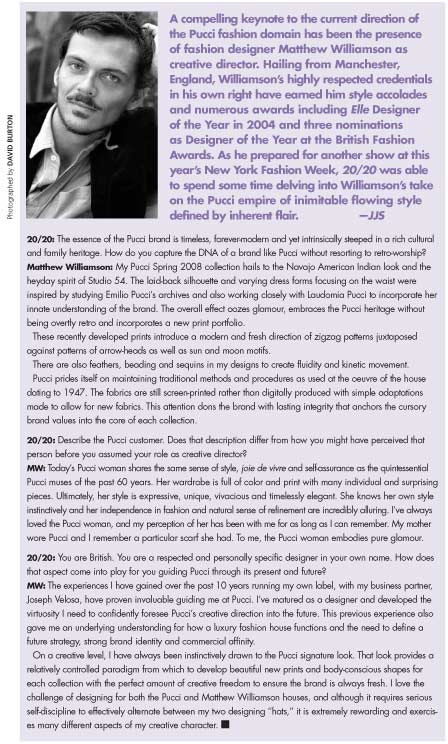
THE EVOLUTION OF A RENAISSANCE MAN AND HIS BRAND
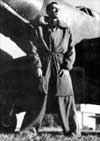
Tracing his origin to centuries-old Florentine aristocracy, Marquis of Barsento EMILIO PUCCI IS BORN IN 1914 in Naples to Orazio Pucci and Neapolitan princess Augusta Pavoncelli. Pucci attends UNIVERSITIES IN AMERICA during the mid-30s and joins the ITALIAN AIR FORCE in 1938.

In 1947 HARPER’S BAZAAR PHOTOGRAPHER TONI FRISSEL urges Pucci to develop some self-designed skiwear. Photos of the striking styles are featured in Bazaar. Interest from American department stores blossoms and fuels Pucci’s drive to create and build on his innate designer talent.
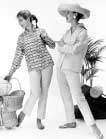
ELEMENTS IN THE UNIQUE PUCCI FASHION FORMULA: A combination of a woman’s finest qualities of grace and mystery with service that Pucci considered the main function of fashion.
Pucci develops his style in a leap of color and abstraction as his influence flies from the ski slopes to the sea in a small COLLECTION OF SPORTSWEAR conceived in 1949 as he vacationed on the island of CAPRI.

In rapid (and successful) succession during the early ’50s Pucci pioneers legendary SILK SHIRTS, CAPRI PANTS, SILK JERSEY DRESSES and his iconic take on SCARVES as a true fashion art form. Paramount to his conception of clothing every Pucci piece of apparel delivers the message of a woman’s body in constant motion.
In 1954 Pucci is honored with the prestigious NEIMAN-MARCUS AWARD as the New York Times concurs: “We owe Fashion Casuals to Marquis Emilio Pucci.” And Pucci reciprocates, noting that if clothing can liberate a body then the mind is also freed to liberation.
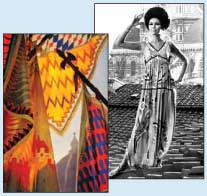 Just as the Chanel suit defined fashion
at its finest formal front, Pucci with his
prints delivered fashion as freedom
and that vitality became a key stamp
on the passport to THE ’60S—A DECADE
VIRTUALLY OWNED BY THE DESIGN VISION
OF EMILIO PUCCI.
Just as the Chanel suit defined fashion
at its finest formal front, Pucci with his
prints delivered fashion as freedom
and that vitality became a key stamp
on the passport to THE ’60S—A DECADE
VIRTUALLY OWNED BY THE DESIGN VISION
OF EMILIO PUCCI.
A KALEIDOSCOPE OF INFLUENCE on the artist as a designer, at this point, moving backward AND forward: Nature, the Mediterranean sea, Florentine architecture, modern architecture, the colorful banners representing Florence as the world’s key pivot of both medieval and Renaissance cultures, places (Russia, Bali, Capri, Sicily, China, Sienese horse racing).
Crucial to his powerful karma, Pucci marries CRISTINA NANNINI (his “Botticelli!”) early in 1959. Son ALESSANDRO is born by year’s end. Daughter LAUDOMIA is born in 1961.
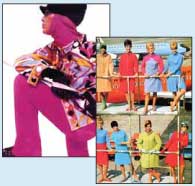 A swing through the ’60s includes Pucci’s legendary Capsulas
(bodysuits), clutch dresses (made by sewing together scarves),
designs for the American Space Program, lingerie (a designer
brand first), awards from Sports Illustrated for
his contributions to sportswear, a first haute
couture collection paying homage to Jacqueline
Kennedy, an influx of geometric scarf prints and
the launch of Pucci’s Vivara perfume with packaging
based on the Pucci VIVARA scarf print.
A swing through the ’60s includes Pucci’s legendary Capsulas
(bodysuits), clutch dresses (made by sewing together scarves),
designs for the American Space Program, lingerie (a designer
brand first), awards from Sports Illustrated for
his contributions to sportswear, a first haute
couture collection paying homage to Jacqueline
Kennedy, an influx of geometric scarf prints and
the launch of Pucci’s Vivara perfume with packaging
based on the Pucci VIVARA scarf print.
WANT MORE ’60S? Mid-decade Pucci was commissioned to design the stewardess uniforms for Braniff Airlines. It probably remains his most globally recognized task of success. It was, in fact, so powerful that in 1974 Qantas extended the same invitation. Those uniforms remained in flight until 1985.

MORE (AS THE ’60S EVOLVED INTO THE ’70S) Sheets, towels, home furnishings (now a master at turning commodities into fashion), literary references in Tom Wolfe’s “Radical Chic,” the absolute lord of the mini dress, Isaac Hayes wearing a Pucci cape on an album cover… and a personal aside from this writer: At some point in the late ’60s or early ’70s my dear Aunt Lee (a fabric draper for designer Molly Parness) considered purchasing a Westinghouse stove, tempted by the company’s premium of a scarfdesigned by the Prince of Prints, Emilio Pucci. In 1977 Pucci has a blast putting customizing touches on a LINCOLN CONTINENTAL Mark IV. His 1982 “LADY LOOK” collection is dedicated to Princess Diana.
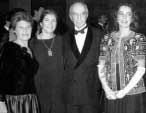
In 1985 Pucci attends the opening of New York’s F.I.T. (Fashion Institute of Technology) exhibition “ITALIA, THE GENIUS OF FASHION” with his daughter Laudomia. Knowing I am a devoted Pucci fan, W Magazine’s John B. Fairchild secures an invite for me. At that time Mr. Fairchild tells me “The Pucci look and style will continue to surge in influence every time fashion needs an injection of color, flair and clothes that fit like skin. The Pucci look is sexy and simple even with all that color. And that look always wins.”
That prediction holds true as Pucci retires (and passes away on November 29, 1992) and Laudomia steers the business to new success as the design house receives the COUNCIL OF FASHION DESIGNERS OF AMERICA AWARD.

In 2000 luxury leader LVMH acquires a controlling interest in Pucci, an infusion guaranteeing continued success and growth in the arena of branding, marketing and development of the style leadership now to the brand created by Emilio. LVMH chooses British designer MATTHEW WILLIAMSON as the new creative director to work in partnership with Laudomia.
The PUCCI BRAND AND PRODUCT PRESENCE GROWS solidly and surely throughout the 21st century, again acknowledged as a leader but, more importantly, as being decidedly original in its approach and ever faithful to the dream of a man who signed his work simply as Emilio.
Which brings us to 2008 and the introduction of new, trendsetting PUCCI EYEWEAR AND SUNWEAR COLLECTIONS in potent teamwork with MARCHON EYEWEAR.

Tracing his origin to centuries-old Florentine aristocracy, Marquis of Barsento EMILIO PUCCI IS BORN IN 1914 in Naples to Orazio Pucci and Neapolitan princess Augusta Pavoncelli. Pucci attends UNIVERSITIES IN AMERICA during the mid-30s and joins the ITALIAN AIR FORCE in 1938.

In 1947 HARPER’S BAZAAR PHOTOGRAPHER TONI FRISSEL urges Pucci to develop some self-designed skiwear. Photos of the striking styles are featured in Bazaar. Interest from American department stores blossoms and fuels Pucci’s drive to create and build on his innate designer talent.

ELEMENTS IN THE UNIQUE PUCCI FASHION FORMULA: A combination of a woman’s finest qualities of grace and mystery with service that Pucci considered the main function of fashion.
Pucci develops his style in a leap of color and abstraction as his influence flies from the ski slopes to the sea in a small COLLECTION OF SPORTSWEAR conceived in 1949 as he vacationed on the island of CAPRI.

In rapid (and successful) succession during the early ’50s Pucci pioneers legendary SILK SHIRTS, CAPRI PANTS, SILK JERSEY DRESSES and his iconic take on SCARVES as a true fashion art form. Paramount to his conception of clothing every Pucci piece of apparel delivers the message of a woman’s body in constant motion.
In 1954 Pucci is honored with the prestigious NEIMAN-MARCUS AWARD as the New York Times concurs: “We owe Fashion Casuals to Marquis Emilio Pucci.” And Pucci reciprocates, noting that if clothing can liberate a body then the mind is also freed to liberation.
 Just as the Chanel suit defined fashion
at its finest formal front, Pucci with his
prints delivered fashion as freedom
and that vitality became a key stamp
on the passport to THE ’60S—A DECADE
VIRTUALLY OWNED BY THE DESIGN VISION
OF EMILIO PUCCI.
Just as the Chanel suit defined fashion
at its finest formal front, Pucci with his
prints delivered fashion as freedom
and that vitality became a key stamp
on the passport to THE ’60S—A DECADE
VIRTUALLY OWNED BY THE DESIGN VISION
OF EMILIO PUCCI.
A KALEIDOSCOPE OF INFLUENCE on the artist as a designer, at this point, moving backward AND forward: Nature, the Mediterranean sea, Florentine architecture, modern architecture, the colorful banners representing Florence as the world’s key pivot of both medieval and Renaissance cultures, places (Russia, Bali, Capri, Sicily, China, Sienese horse racing).
Crucial to his powerful karma, Pucci marries CRISTINA NANNINI (his “Botticelli!”) early in 1959. Son ALESSANDRO is born by year’s end. Daughter LAUDOMIA is born in 1961.
 A swing through the ’60s includes Pucci’s legendary Capsulas
(bodysuits), clutch dresses (made by sewing together scarves),
designs for the American Space Program, lingerie (a designer
brand first), awards from Sports Illustrated for
his contributions to sportswear, a first haute
couture collection paying homage to Jacqueline
Kennedy, an influx of geometric scarf prints and
the launch of Pucci’s Vivara perfume with packaging
based on the Pucci VIVARA scarf print.
A swing through the ’60s includes Pucci’s legendary Capsulas
(bodysuits), clutch dresses (made by sewing together scarves),
designs for the American Space Program, lingerie (a designer
brand first), awards from Sports Illustrated for
his contributions to sportswear, a first haute
couture collection paying homage to Jacqueline
Kennedy, an influx of geometric scarf prints and
the launch of Pucci’s Vivara perfume with packaging
based on the Pucci VIVARA scarf print.
WANT MORE ’60S? Mid-decade Pucci was commissioned to design the stewardess uniforms for Braniff Airlines. It probably remains his most globally recognized task of success. It was, in fact, so powerful that in 1974 Qantas extended the same invitation. Those uniforms remained in flight until 1985.

MORE (AS THE ’60S EVOLVED INTO THE ’70S) Sheets, towels, home furnishings (now a master at turning commodities into fashion), literary references in Tom Wolfe’s “Radical Chic,” the absolute lord of the mini dress, Isaac Hayes wearing a Pucci cape on an album cover… and a personal aside from this writer: At some point in the late ’60s or early ’70s my dear Aunt Lee (a fabric draper for designer Molly Parness) considered purchasing a Westinghouse stove, tempted by the company’s premium of a scarfdesigned by the Prince of Prints, Emilio Pucci. In 1977 Pucci has a blast putting customizing touches on a LINCOLN CONTINENTAL Mark IV. His 1982 “LADY LOOK” collection is dedicated to Princess Diana.

In 1985 Pucci attends the opening of New York’s F.I.T. (Fashion Institute of Technology) exhibition “ITALIA, THE GENIUS OF FASHION” with his daughter Laudomia. Knowing I am a devoted Pucci fan, W Magazine’s John B. Fairchild secures an invite for me. At that time Mr. Fairchild tells me “The Pucci look and style will continue to surge in influence every time fashion needs an injection of color, flair and clothes that fit like skin. The Pucci look is sexy and simple even with all that color. And that look always wins.”
That prediction holds true as Pucci retires (and passes away on November 29, 1992) and Laudomia steers the business to new success as the design house receives the COUNCIL OF FASHION DESIGNERS OF AMERICA AWARD.

In 2000 luxury leader LVMH acquires a controlling interest in Pucci, an infusion guaranteeing continued success and growth in the arena of branding, marketing and development of the style leadership now to the brand created by Emilio. LVMH chooses British designer MATTHEW WILLIAMSON as the new creative director to work in partnership with Laudomia.
The PUCCI BRAND AND PRODUCT PRESENCE GROWS solidly and surely throughout the 21st century, again acknowledged as a leader but, more importantly, as being decidedly original in its approach and ever faithful to the dream of a man who signed his work simply as Emilio.
Which brings us to 2008 and the introduction of new, trendsetting PUCCI EYEWEAR AND SUNWEAR COLLECTIONS in potent teamwork with MARCHON EYEWEAR.
—James J. Spina










